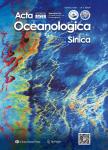Circulation in the South China Sea is in a state of forced oscillation:Results from a simple reduced gravity model with a closed boundary
Circulation in the South China Sea is in a state of forced oscillation: Results from a simple reduced gravity model with a closed boundary作者机构:Woods Hole Oceanographic InstitutionWoods HoleFalmouthMassachusetts02543USA Key Laboratory of Ocean Circulation and WavesInstitute of OceanologyChinese Academy of SciencesQingdao266071China Laboratory for Ocean Dynamics and ClimatePilot National Laboratory for Marine Science and Technology(Qingdao)Qingdao266237China University of Chinese Academy of SciencesBeijing100049China
出 版 物:《Acta Oceanologica Sinica》 (海洋学报(英文版))
年 卷 期:2022年第41卷第7期
页 面:1-12页
核心收录:
基 金:The Strategic Priority Research Program of the Chinese Academy of Sciences under contract No.XDB42000000 the National Natural Science Foundation of China under contract No.41876009.
主 题:South China Sea ocean circulation annual cycle first baroclinic Rossby wave propagation western boundary current forced ossilation
摘 要:The South China Sea(SCS)is a narrow semi-enclosed basin,ranging from 4°–6°N to 21°–22°N meridionally.It is forced by a strong annual cycle of monsoon-related wind stress.The Coriolis parameter f increases at least three times from the southern basin to the northern basin.As a result,the basin-cross time for the first baroclinic Rossby wave in the southern part of the basin is about 10-times faster than that in the northern part,which plays the most vitally important role in setting the circulation.At the northernmost edge of SCS,the first baroclinic Rossby wave takes slightly less than 1 year to move across the basin,however,it takes only 1–2 months in the southernmost part.Therefore,circulation properties for a station in the model ocean are not solely determined by the forcing at that time instance only;instead,they depend on the information over the past months.The combination of a strong annual cycle of wind forcing and large difference of basin-cross time for the first baroclinic Rossby wave leads to a strong seasonal cycle of the circulation in the SCS,hence,the circulation is dominated by the forced oscillations,rather than the quasi-steady state discussed in many textbooks.The circulation in the SCS is explored in detail by using a simple reduced gravity model forced by seasonally varying zonal wind stress.In particular,for a given time snap the western boundary current in the SCS cannot play the role of balancing mass transport across each latitude nor balancing mechanical energy and vorticity in the whole basin.In a departure from the steady wind-driven circulation discussed in many existing textbooks,the circulation in the SCS is characterized by the imbalance of mechanical energy and vorticity for the whole basin at any part of the seasonal cycle.In particular,the western boundary current in the SCS cannot balance the mass,mechanical energy,and vorticity in the seasonal cycle of the basin.Consequently,the circulation near the western boundary cannot be interpreted in terms of the wind stress and thermohaline forcing at the same time.Instead,circulation properties near the western boundary should be interpreted in terms of the contributions due to the delayed wind stress and the eastern boundary layer thickness.In fact,there is a clear annual cycle of net imbalance of mechanical energy and vorticity source/sink.Results from such a simple model may have important implications for our understanding of the complicated phenomena in the SCS,either from in-situ observations or numerical simulations.



